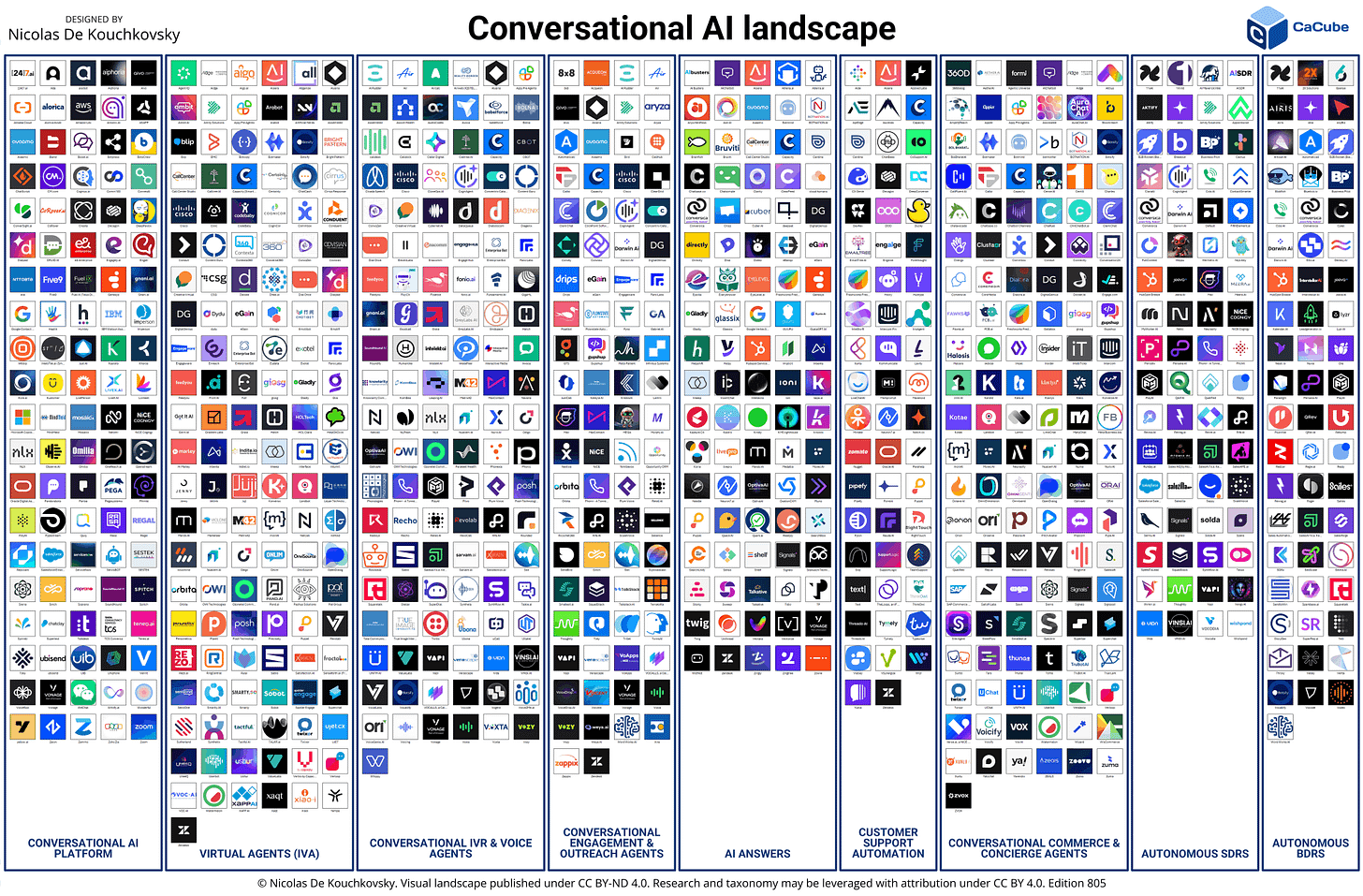650.
That’s the staggering number of companies offering conversational AI solutions for sales and service.
The flood isn’t slowing: each week brings new entrants or announcements. A year ago, the market was already crowded; today, the latest wave of AI technologies has lowered the barriers to entry even further, fueling an unsustainable proliferation. Let’s not forget that, beyond the three hyperscalers, only a handful of providers have surpassed $100M in ARR.
I spent the summer making sense of the mayhem. The result: nine categories mapped to the core jobs-to-be-done.
Customer service and support solutions can be grouped into four main categories:
Virtual Agents. These include Intelligent Virtual Agents (IVAs) and their evolution into AI agents. They operate across digital channels, handling transactional interactions and escalating to human agents when necessary.
AI Answer Engines. These systems handle inquiries by retrieving and formatting answers from knowledge bases. Generative AI has dramatically transformed how informational inquiries are addressed, enabling much more precise and accurate responses.
Conversational IVR and Voice Agents. Voice remains complex and full of nuance. These agents are primarily focused on transactional interactions.
Conversational Engagement and Outreach Agents. These handle outbound communications, engaging customers across voice, SMS, and messaging channels. They must comply with numerous regulations. Historically transactional—covering sales, service, payments, and collections—they are now expanding to let customers explore options and engage more dynamically.
Sales solutions can be broken down into three main categories:
Conversational Commerce & Concierge Agents. As the name suggests, these are the evolution of conversational commerce. They represent one of the most mature agent use cases, set to replace traditional web and in-app chat with genuinely conversational experiences. They handle the full spectrum of assistance scenarios across both pre-sales and post-sales. The emerging term “Concierge” captures their versatility in guiding customers seamlessly through the journey.
Autonomous SDRs (Sales Development Reps). These agents manage inbound inquiries. While Conversational Commerce & Concierge Agents focus on B2C and e-commerce, Autonomous SDRs are built for complex B2B scenarios, enriching and qualifying leads, routing them to the right sellers, and scheduling appointments. This is among the most mature AI applications for B2B sales.
Autonomous BDRs (Business Development Reps). These agents drive outbound sales motions, a use case that demands extreme relevance. At this stage, they are complex to implement, difficult to scale, and best applied in highly targeted scenarios where flawless personalization is possible, as poorly executed machine outreach can severely damage the brand.
Several providers offer platforms that span the full spectrum of service use cases, as well as Conversational Commerce and Concierge Agents. Rather than duplicating them across all five categories, I group them under a Conversational AI Platform category. Their ability to support these use cases rests on robust platform capabilities for designing, evaluating, deploying, and continuously improving applications and agents.
Another emerging platform category is Customer Support Automation, tailored for handling support requests. It is a natural fit for GenAI and complementary technologies such as knowledge graphs. Optimized for email and messaging channels, these platforms go beyond answering questions to deliver full resolutions whenever possible. They automate resolution workflows, including case creation, triage, and handoff, while assisting agents with context and guidance. This has become a mature use case for Agentic AI, with many providers publicly showcasing impressive results in transforming customer support operations. As with Conversational AI Platforms, I avoid duplicating them across other categories where they may also participate.
The visual landscape below captures this segmentation. A few vendors will evolve into true platforms, while others will carve out success in specialized niches or become embedded within broader applications. The market remains in motion, and I welcome perspectives on what I may have overlooked.
High-resolution landscape: here



